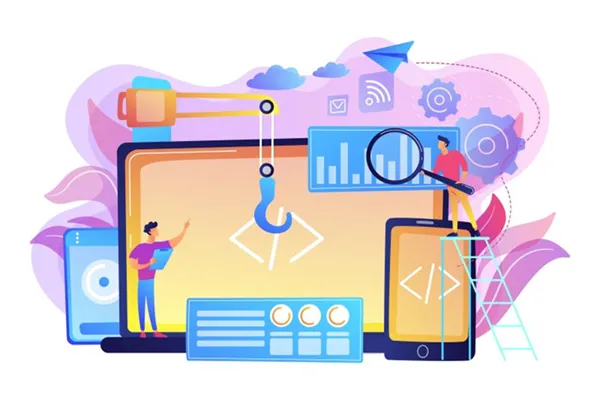NEW PRODUCT LAUNCH: AuditLens AI - Nuclear Compliance Automation Limited Pilot Program Spots Available →
NEW PRODUCT LAUNCH: AuditLens AI - Nuclear Compliance Automation Limited Pilot Program Spots Available →
ETHANY Blog
ETHANY Blog

Custom App Development Methods and Practices
When buying off the shelf won't meet all your needs, it's time to go custom. In the IT world, custom software application development is one of the best ways to ensure your company has the individualized capabilities it needs to be competitive in today's market.
Off the Shelf vs. Custom Made
If an application isn't developed specifically for your needs, it's considered "off-the-shelf" software. These are mass-produced solutions designed to meet as many of the needs of as many businesses as possible. And while some customization may be possible - significant changes that make your life easier aren't.
And because Off-the-Shelf products are developed with many different users in mind, they will likely have many features you don't need or want. Yet you're still paying for them, even if you never use them.
Bottom Line: Custom applications are written for your needs and not the needs of anyone else.
The advantages of Custom Made:
Cross-platform application: You are in charge when you order a custom app development. You decide which OSs, devices, models, and browsers and which versions will be supported by the app.
Security Your Way: Security features are a critical element of customization because your development team can build in any security feature you need (two-step verification, blockchain, ciphered data, etc.) Control over security decreases the risk of piracy.
Building to Scale: Customs apps are often designed with the future vision in mind. This allows you to grow to scale, connect to other services, add new features, etc. Of course, this practice works best when you use the same development team for the current and future app building.
Cloud-Based Storage: Customized applications are frequently stored on a cloud to provide for the fast and efficient work of the app, while the off-the-shelf versions require a server to run from. Adding in a unique server adds both extra cost and a higher risk of the app crashing.
The Custom App Development Process
Step #1: Map your Current Needs and Gaps
You’ve identified a pain point in your business deliverables or process and you know you need a custom solution. Therefore your first step is to precisely define the purpose of the app. What business problem are you trying to solve?
Things to consider:
What capabilities does this app need to have to make an impact on your business?
Reporting? Translating from one system to another? etc.
What off-the-shelf solution closely met your needs, but didn’t? Define what capabilities were missing that are critical to your business.
Step #2: Define How This Integrates into your Business
Businesses rarely run on just one existing system nor do they run in isolation of external systems or, even, regulations. The reason you’re probably choosing to go with custom is because of the existing software and set of SOPs that run your business. How will this app improve how the existing cogs work together to improve quality, output or any other critical measure of business performance?
Things to consider:
How will this app fit into your existing infrastructure and processes?
What SOPs are already in place? What would change once this app is built?
What existing systems will need to communicate with this app once complete?
Step #3: Design of Core Functions
Creating the specifications for your core functions is an essential step. Don't worry if you're not a tech person and cannot define the specification in IT terms. The overall functional and technical specifications or your expectations for the future will help website and mobile app developers understand your vision and create the exact solution you need.
Things to consider:
User Roles: Spend time thinking about exactly who will be using the app. For instance - teachers or students, self-learners, registered/non-registered users, returning or new customers, etc. The roles heavily rely on your app's general idea.
User journeys: consider how each defined role will use your app or how you want them to do so. The easiest way is a flow chart with arrows and particular elements of the app.
Plan the app: this means only high-level planning like the expected number of screens and their names, buttons, and functional design.
Set up a list of features: what you expect the app to do.
Step #5: Find Your Expert
Now it's time to find the right Custom App Development for you. At Ethany, we look to partner with companies who are ready to make their lives easier by creating apps that work for your business.
We are always available to meet with your team to understand the current challenges and identify how ETHANY's services can assist in providing a support structure to meet your needs.
Step #6: Design & Development
Now the magic starts to happen. During the design phase, ETHANY helps clients create low-cost prototypes.
We focus on the horizontal dimension of the prototyping process to provide a clearer view of the project, idea, and system. Our team works promptly to allow time for evaluation by:
Ensuring projected schedules are met
Managing resources
The Bottom Line
Custom software application development is about more than having a piece of software to call your own. It's about having a flexible, powerful tool that can give your company the edge it needs for today and the future. If you're tired of software that only seems to slow you down, it's time to invest in a solution that actually works. Contact Ethany to find out how they can help make a custom solution that fits your needs.
Get started free
We start every client interaction with a free strategy session to help determine the right solution for your business right now and how to best make your business future-proof.
Please send us a bit of information about yourself. To prepare you for our conversation, these are some of the questions we ask:
Who you are?
What's your business
How can we help you?
When would you be ready to start?
Are you happy with your business software solutions today?
Where would you like to see your business software solutions go in the future?
We are looking forward to chatting with you soon!
Let's Talk!
By providing my phone number to ETHANY Corp., I agree and acknowledge that ETHANY may send text messages to my wireless phone number for any purpose. Message and data rates may apply. Message frequency will vary, and you will be able to Opt-out by replying “STOP”. For more information on how your data will be handled, please visit https://www.ethany.com/policies




